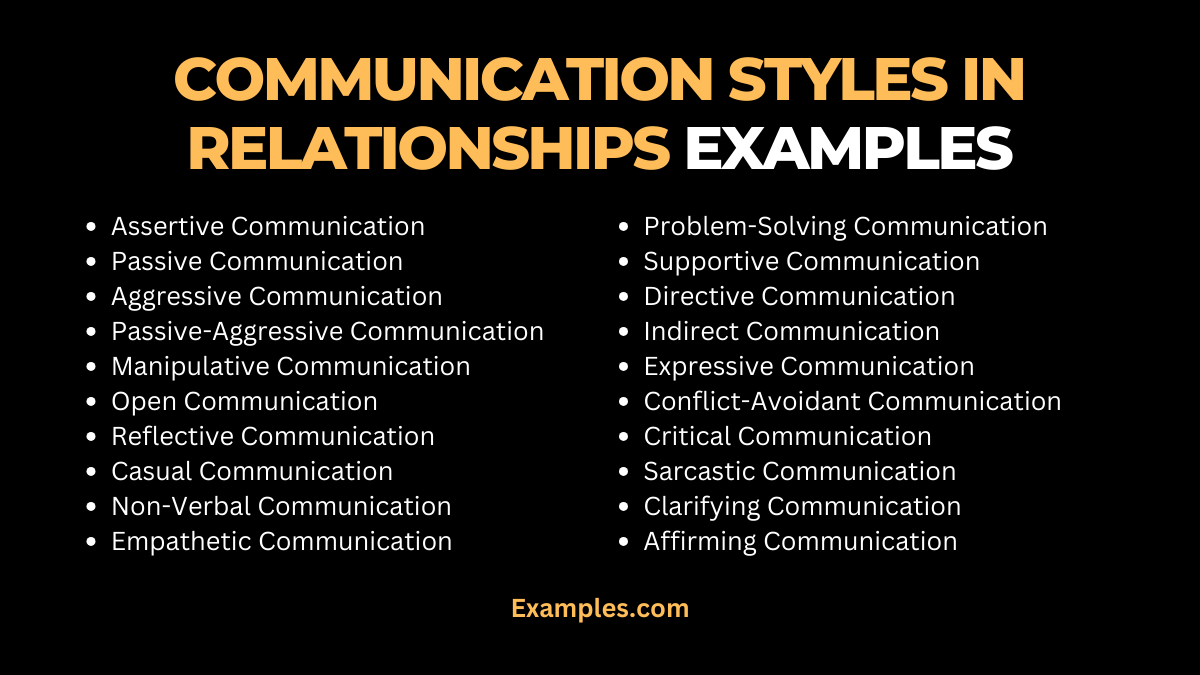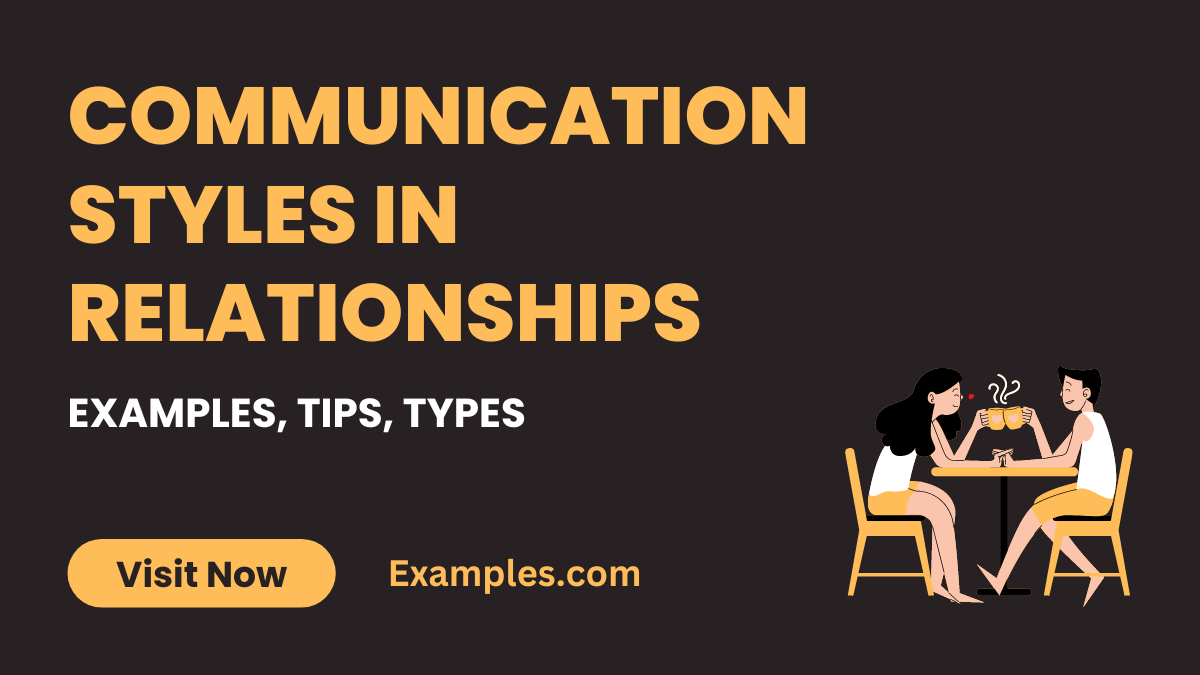19+ Communication Styles in Relationships Examples
Deepen your understanding of interpersonal dynamics with our comprehensive guide on Communication Styles in Relationships. Packed with enlightening Communication Objective Examples, this guide explores the diverse range of communication styles that influence relationships. From assertive to passive-aggressive, each style plays a crucial role in the health and understanding of interpersonal connections. Ideal for those seeking to improve communication with partners or gain insights into relationship dynamics, our guide offers effective strategies and examples for nurturing healthy, effective communication.
What are The Communication Styles in Relationships?

Communication Styles in Relationships refer to the various ways individuals express and exchange information, feelings, and thoughts with their partners. These styles can significantly affect the quality and dynamics of a relationship. Common styles include assertive, passive, aggressive, and passive-aggressive. Each style has distinct characteristics – assertive communication is direct and respectful, passive is often yielding, aggressive can be dominating, and passive-aggressive is indirectly hostile. Understanding these styles is crucial for healthy and effective communication in relationships, impacting both relationship building and conflict resolution.
20 Communication Styles in Relationships Examples
Exploring Communication Styles in Relationships is key to fostering healthier and more fulfilling connections. Our guide presents 20 unique examples of these styles, each illustrating how different approaches to communication can influence relationship dynamics. From the clarity of assertive communication to the subtleties of passive-aggressive interactions, these examples provide insights into effectively navigating conversations with partners. Understanding these styles is essential for building stronger bonds, resolving conflicts, and enhancing mutual understanding in relationships.

- Assertive Communication: Direct and respectful, valuing both personal rights and others’ needs.
Example: “I feel hurt when you interrupt me. Can we discuss this calmly?” - Passive Communication: Avoiding confrontation and prioritizing others’ needs over self.
Example: “It’s okay, I don’t mind changing our plans if you’re busy.” - Aggressive Communication: Dominating and often disrespectful, prioritizing self-needs aggressively.
Example: “You always make us late! You need to speed things up!” - Passive-Aggressive Communication: Indirectly expressing negative feelings or hostility.
Example: “Sure, go out with your friends. I’ll just stay home alone, as usual.” - Manipulative Communication: Influencing or controlling others subtly or deceptively.
Example: “If you loved me, you wouldn’t spend so much time at work.” - Open Communication: Honest and transparent, sharing thoughts and feelings freely.
Example: “I want to talk about our finances openly to plan our future better.” - Reflective Communication: Listening actively and echoing back the message for clarity.
Example: “So you’re saying you feel overwhelmed at work, right?” - Casual Communication: Light-hearted and informal, often used in comfortable, familiar relationships.
Example: “Hey, how was your day? Anything fun happen?” - Non-Verbal Communication: Communicating feelings or thoughts without words, through body language, facial expressions, and gestures.
Example: A comforting hug when your partner is upset, without needing words. - Empathetic Communication: Understanding and sharing the feelings of your partner.
Example: “I can see why you’re upset, and it’s completely valid to feel that way.” - Problem-Solving Communication: Focusing on resolving issues constructively together.
Example: “Let’s figure out a solution that works for both of us.” - Supportive Communication: Offering encouragement and understanding in conversations.
Example: “I’m here for you, no matter what you decide.” - Directive Communication: Giving clear instructions or guidance in decision-making.
Example: “I think it’s best if we start saving for that trip now.” - Indirect Communication: Hinting or suggesting without saying something directly.
Example: “It’s getting late, isn’t it? Maybe it’s time to head home.” - Expressive Communication: Sharing thoughts and feelings openly and freely.
Example: “I’m really excited about these plans, they mean a lot to me.” - Conflict-Avoidant Communication: Steering away from topics that might lead to disagreement.
Example: “Maybe we shouldn’t talk about politics right now.” - Critical Communication: Focusing on finding faults or criticizing aspects of the partner’s behavior.
Example: “You never think about how your actions affect others.” - Sarcastic Communication: Using irony or sarcasm, sometimes humorously or hurtfully.
Example: “Yeah, right, like you’re the expert on this!” - Clarifying Communication: Asking questions to understand the partner’s message better.
Example: “Can you explain what you mean by that?” - Affirming Communication: Recognizing and validating the partner’s feelings or opinions.
Example: “I appreciate your perspective on this issue.”
Each example represents a communication style that can significantly impact the health and happiness of a relationship. By understanding and adapting these styles, couples can improve their communication, leading to stronger and more understanding relationships.
5 Main Communication Styles in Relationships
Understanding the communication styles in relationships is essential for fostering a healthy and fulfilling connection between partners. Each style influences the dynamics and outcomes of interactions, making it crucial to recognize and adapt them appropriately. Here are the five main communication styles found in relationships:
- Assertive Communication Style: This style is key for effective and healthy interactions. It involves expressing one’s opinions and needs openly and honestly, while also respecting others. It’s considered the most effective and Communication Style for Relationships, promoting mutual respect and understanding.
- Passive Communication Style: Often observed in relationships, this style is characterized by a reluctance to express thoughts and feelings. While it might prevent conflicts, it can lead to unaddressed issues and dissatisfaction, affecting the overall Communication Style for Work and personal life balance.
- Aggressive Communication Style: This confrontational style can be detrimental to relationships. It involves dominating conversations and disregarding others’ opinions, which can lead to conflicts and discomfort, contrasting the desired Communication Style for Coaching in a relationship.
- Passive-Aggressive Communication Style: A subtle yet harmful style, it combines passive and aggressive behaviors. It often leads to indirect expressions of hostility, which can undermine the Open Communication Style necessary for a healthy relationship.
- Manipulative Communication Style: This style involves influencing others for personal gain. It’s detrimental to trust and openness, contrasting starkly with the Reflective Communication Style, which is based on understanding and empathy.
Each of these styles contributes uniquely to the communication dynamics in relationships. Recognizing and adapting them can lead to improved interactions and a more harmonious relationship.
What are the Communication Styles in Love Relationships?
In love relationships, communication takes on a more profound significance, with emotions deeply intertwined. Here’s a look at some key communication styles in love relationships:
- Open Communication Style: Essential in love relationships, it involves honest and transparent sharing of thoughts and feelings. It’s the cornerstone of trust and understanding, aligning with the Communication Style for Relationships that nurtures connection and intimacy.
- Reflective Communication Style: This empathetic style is vital in love relationships. It involves active listening and thoughtful responses, demonstrating a deep understanding and Communication Style for Leaders in a relationship.
- Casual Communication Style: Keeping communication light and informal can strengthen love relationships. This style fosters a relaxed and comfortable atmosphere, similar to the Communication Style for Students in creating an approachable and friendly environment.
- Communication Style for Influencer: In love relationships, this style can play a significant role. It involves inspiring and motivating one’s partner, akin to the Communication Style for Project Managers, focusing on growth and positive change.
- Communication Style for Coaching: Similar to coaching, this style in love relationships is about offering support and guidance. It mirrors the Communication Style for Managers, focusing on development and mutual growth.
By understanding and integrating these styles, partners in love relationships can enhance their communication, leading to a deeper, more fulfilling connection.
Types of Communication Styles in Relationships
In the landscape of relationships, communication styles play a pivotal role. Understanding these styles not only aids in better interactions but also helps in nurturing a deeper connection. Here are various types of communication styles typically found in relationships:
- Assertive Communication Style: This is the most effective and balanced style. It involves expressing one’s own needs and opinions confidently and respectfully, fostering a Communication Style for Relationships that is both understanding and assertive.
- Passive Communication Style: Characterized by a reluctance to express personal thoughts or needs, this style can lead to misunderstandings and unmet expectations, contrasting with the Open Communication Style that promotes transparency.
- Aggressive Communication Style: This confrontational style can create tension and conflict in relationships. It’s important to recognize and adjust this style to align more closely with a Reflective Communication Style for healthier interactions.
- Passive-Aggressive Communication Style: Often masked by sarcasm or backhanded comments, this style can erode trust and clarity in communication, differing greatly from the Communication Style for Coaching.
- Manipulative Communication Style: Involving subtle control or emotional deception, this style can harm relationship dynamics, contrasting with the Communication Style for Leaders, which is based on mutual respect and honesty.
- Casual Communication Style: This relaxed and informal style can help create a comfortable atmosphere, similar to the Communication Style for Students, fostering ease and openness in conversations.
- Communication Style for Influencer: This style, involving motivation and inspiration, can be beneficial in guiding a relationship towards positive growth and shared goals.
Understanding these types offers insight into how partners interact and how they can improve their communication. Adapting and balancing these styles can lead to a more harmonious and understanding relationship.
Tips for Managing Communication Styles in a Relationship
Managing and adapting communication styles in a relationship is crucial for maintaining a healthy and fulfilling partnership. Here are some tips to effectively manage these styles:
- Recognize Your Own Style: Understand your primary communication style. Whether it’s an Assertive Communication Style or a Passive Communication Style, recognizing it is the first step towards effective communication in relationships.
- Understand Your Partner’s Style: Just as important as knowing your own style is understanding your partner’s. This could range from a Casual Communication Style to a Manipulative Communication Style. Understanding each other’s styles fosters empathy and patience.
- Develop Active Listening Skills: Embrace a Reflective Communication Style. Active listening involves fully concentrating, understanding, and responding thoughtfully to your partner’s words, which is key in a Communication Style for Relationships.
- Practice Open and Honest Communication: Aim for an Open Communication Style. Share your thoughts and feelings honestly and openly, but respectfully. This transparency is crucial in building trust and understanding.
- Adapt and Compromise: Be willing to adapt your style for the health of the relationship. If your partner has a Communication Style for Coaching, for instance, try to be receptive to their guidance and support.
- Seek to Resolve Conflicts Constructively: If conflicts arise, address them using a positive and constructive approach, avoiding the pitfalls of an Aggressive Communication Style.
- Use Positive Reinforcement: Acknowledge and appreciate effective communication efforts. Positive reinforcement can encourage a continued Communication Style for Leaders within the relationship.
- Consider Professional Guidance: If managing communication styles becomes challenging, consider seeking help from a relationship counselor or coach who specializes in Communication Style for Work and personal relationships.
By applying these tips, partners can effectively manage and improve their communication styles, leading to a stronger, more understanding relationship.



